Glazed Orange Sweet Rolls
This post may contain affiliate links. Please read our disclosure policy.
These irresistibly soft and fluffy Glazed Orange Sweet Rolls are the perfect balance of tangy citrus and sweet, gooey glaze. Perfect for breakfast, brunch, or a special treat, these homemade rolls are sure to impress! With a melt-in-your-mouth texture and a zesty orange flavor, they’re a crowd-pleaser every time.
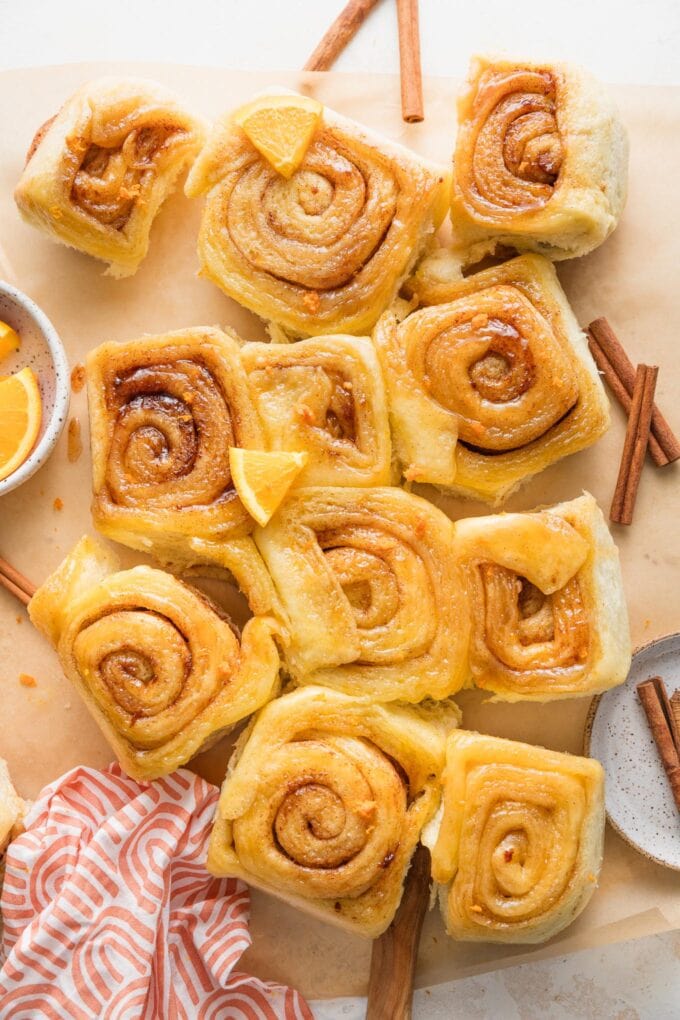
These rolls are a treasured spring tradition in our family. My husband’s mother made glazed orange rolls as an occasional breakfast treat for him and his three siblings, and the love for them is still going strong here. They’re our must-have for Easter morning and equally fitting for any special breakfast or brunch.
It’s hard to say which part is most appealing: the tender, enriched dough; the buttery filling sprinkled with a rich concoction of brown sugar, cinnamon, and orange zest; or the sweet, sticky orange glaze that literally drips from the pan to coat the just-baked rolls.
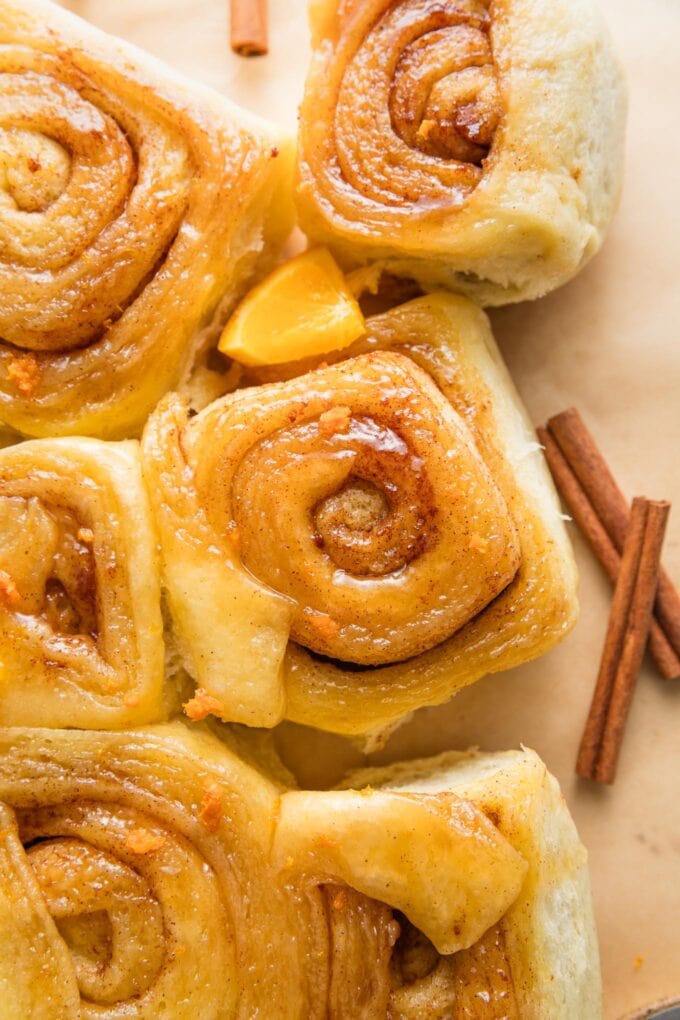
Each layer of these sweet rolls receives its own citrus treatment, so the orange flavor and aroma is undeniable throughout.
- The dough with flecks of orange zest worked right in.
- The filling, which is a typical cinnamon roll filling laced with more orange zest.
- A glossy orange glaze that makes this recipe unique!
My mother-in-law made orange sweet rolls with the same bread dough she used for homemade hamburger buns. I use her same glaze recipe and technique, and over the years have adapted the dough and filling based on what I use for caramel pecan and apple butter cinnamon rolls at other times of the year.
Ingredient Notes
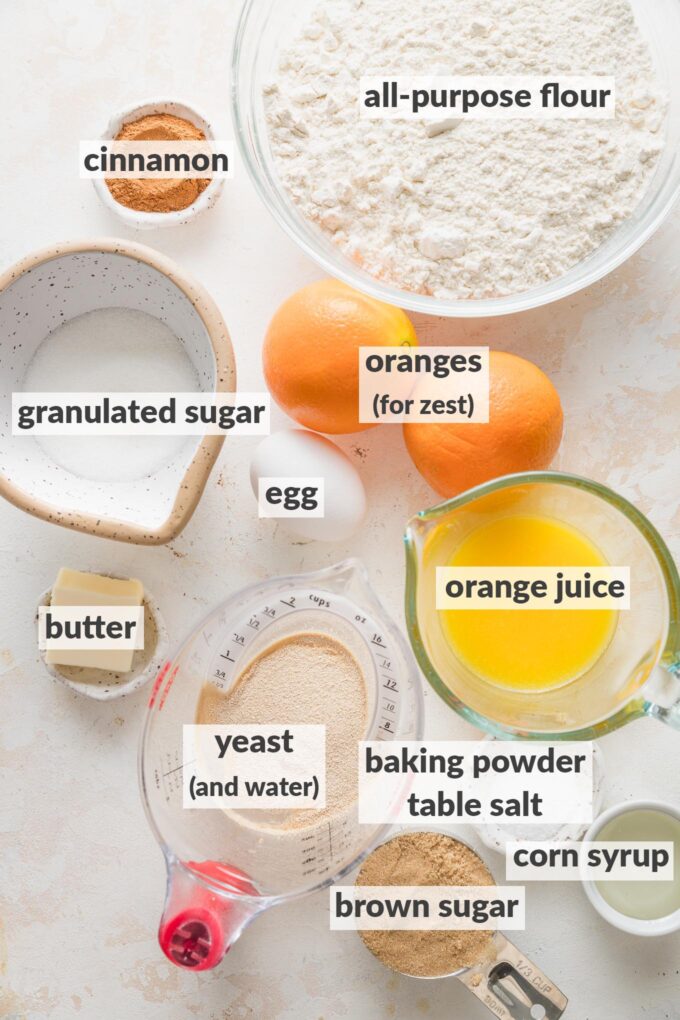
How To Make Orange Sweet Rolls
This is an overview with step-by-step photos to help bakers of all skill levels achieve consistent success. For the full printable recipe instructions and ingredient quantities, scroll to the recipe card at the bottom of this post.
Prepare the dough.
Begin by measuring warm water into a small liquid measuring cup and sprinkling the yeast on top.
Pro Tip
For consistent results, take the temperature of the water you use in the first step. Liquid between 105-110°F is a good temperature to activate yeast: cooler liquid may not start the reaction, while hotter liquid can kill off the yeast completely. The exact preferred temperature can vary depending on the type of yeast (dry vs. active vs. instant) but 105-110°F is a good bet regardless.
As the yeast blooms in the water, combine orange zest and granulated sugar in a large bowl. Rub the two together between your fingers for about 60 seconds. This infuses citrus aroma and flavor into the sugar and throughout the dough. A simple step with big pay-off!
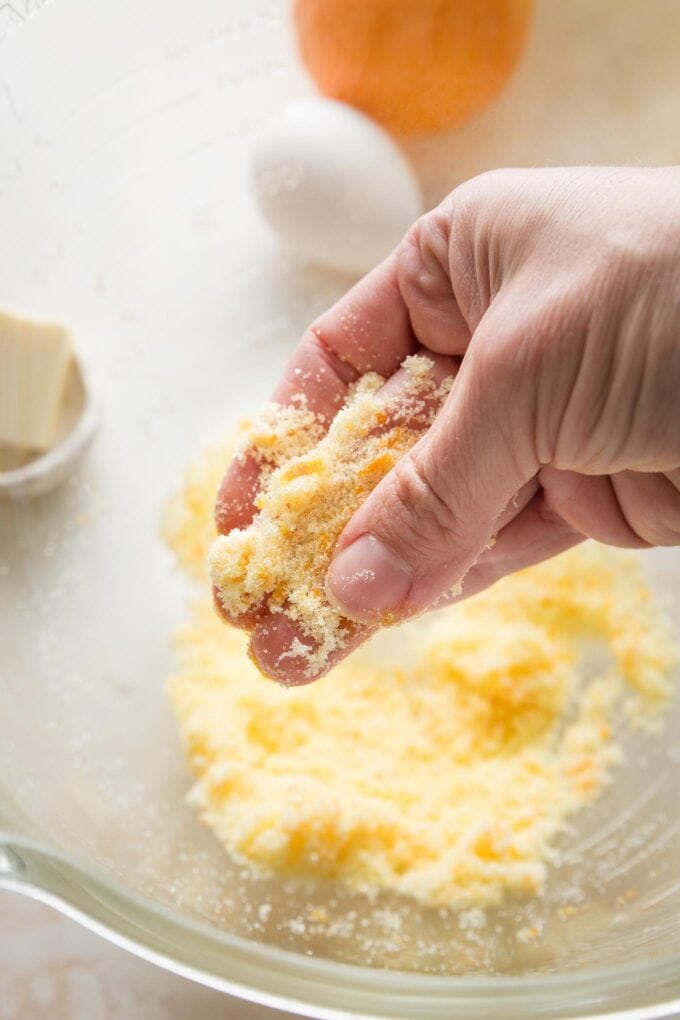
To the sugar, add the yeast-water mixture and the remaining dough ingredients. Knead into a ball that is tacky but not super sticky to the touch. Set aside to rise until doubled in size. This typically takes 1-2 hours and can be expedited by covering the bowl with plastic wrap and setting it in a relatively warm environment.

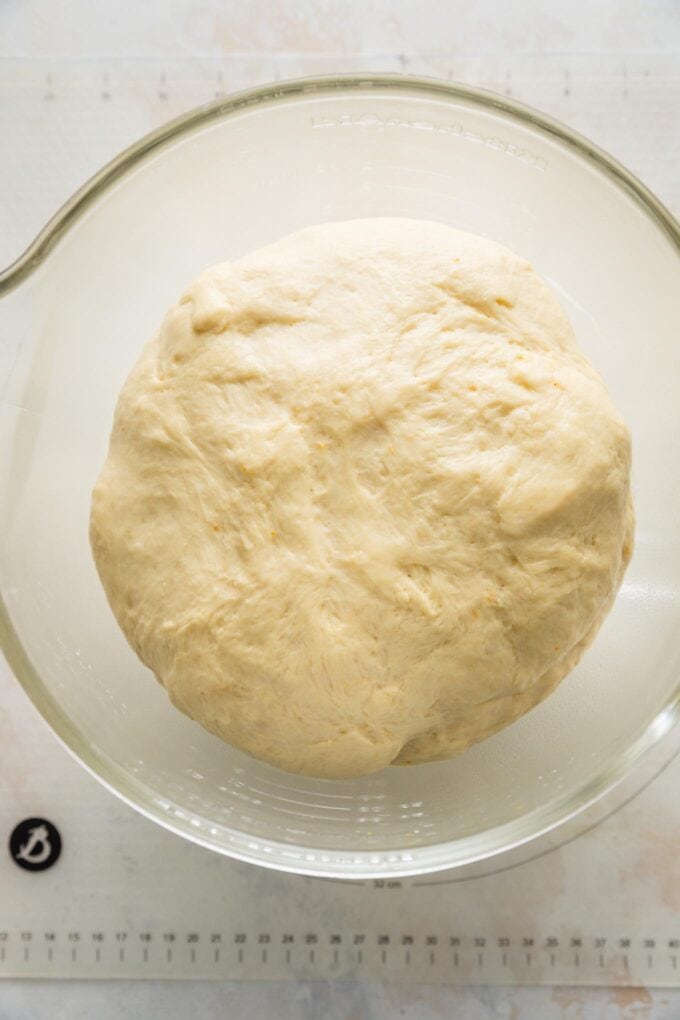
Fill, shape, and glaze.
Prep the filling, pan, and glaze. While the dough completes its first rise, take a few moments to set out butter, make the orange zest-cinnamon-sugar mixture, and grease a 9×13-inch baking pan. Simmer the glaze in a small saucepan, pour it into the greased pan, and set aside. This will let you focus just on assembly when the dough is ready.
Add the filling. When the dough is about doubled in size, punch it down and turn out onto a lightly-floured work surface. Roll it into a large rectangle, spread with softened butter, and sprinkle with the cinnamon-sugar mixture.
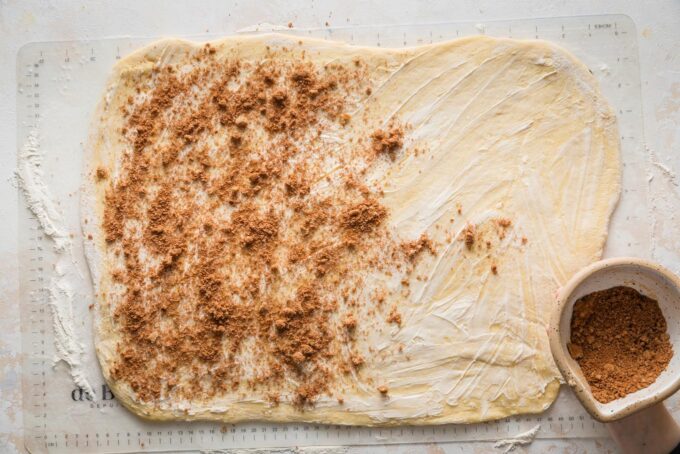
Shape the rolls. Use a pizza wheel or knife to cut the dough rectangle into 12 fairly equal strips, then gently roll each strip up into a cinnamon roll shape.
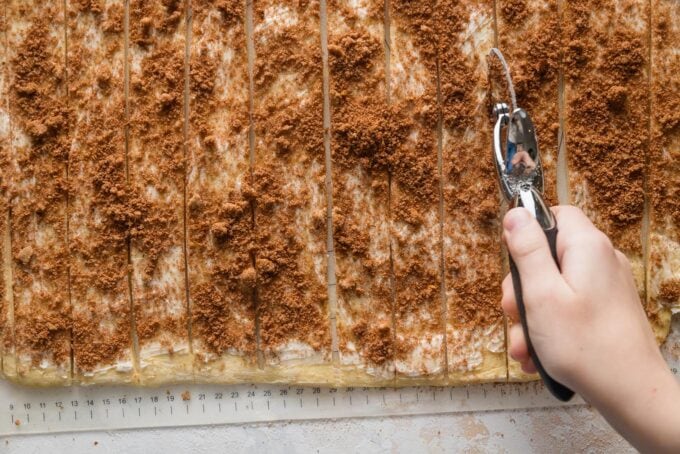
You also can roll up the whole log, then slice that into 12 equal pieces. This is the more traditional method, but I find the “cut, then roll” method transformative for keeping the rolls tall, round, and even.
Plus, “cut, then roll” is fun! You can see my 10-year-old having his turn at the pizza wheel in the photo above. Are they perfectly even? No. Did he have fun? Yes. Were they delicious? Extremely!
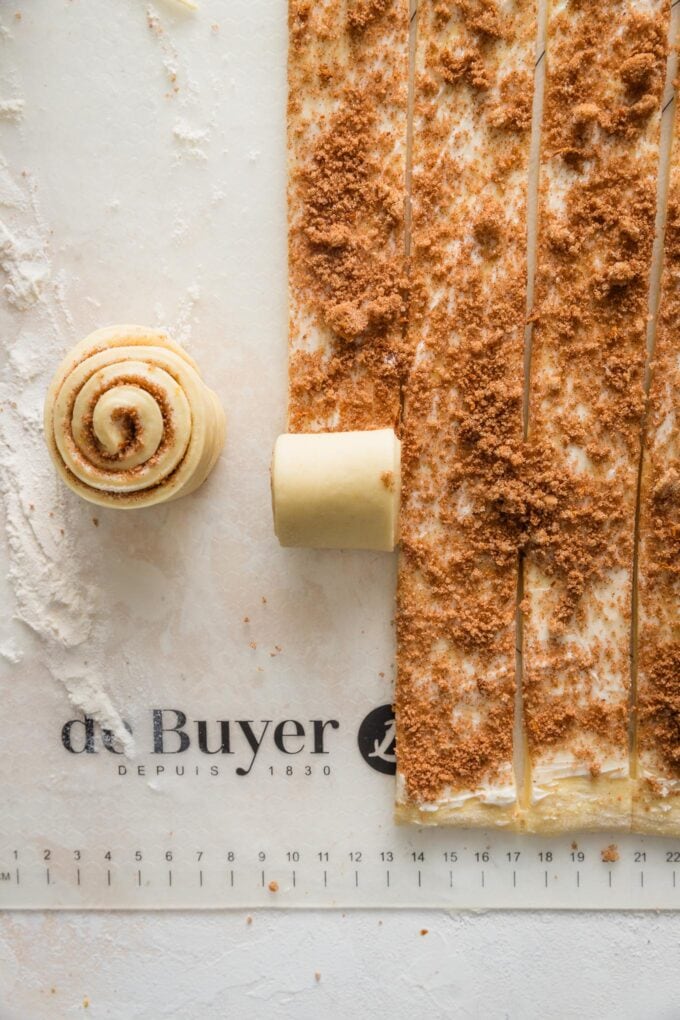
Second rise. Arrange the shaped rolls over the glaze in the baking pan. Leave space between them so they can puff up and spread out. This is what gives the finished rolls that nice, fluffy texture!
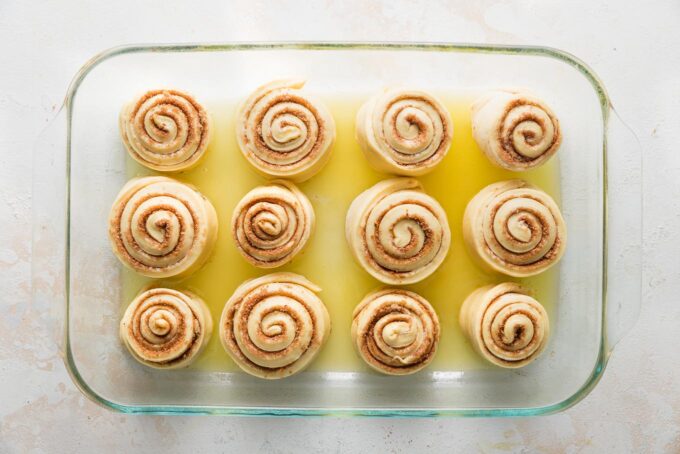
Cover with plastic wrap and set aside for a second rise, just 45 minutes or so this time, until the rolls are puffy and fill out the whole pan, as shown.
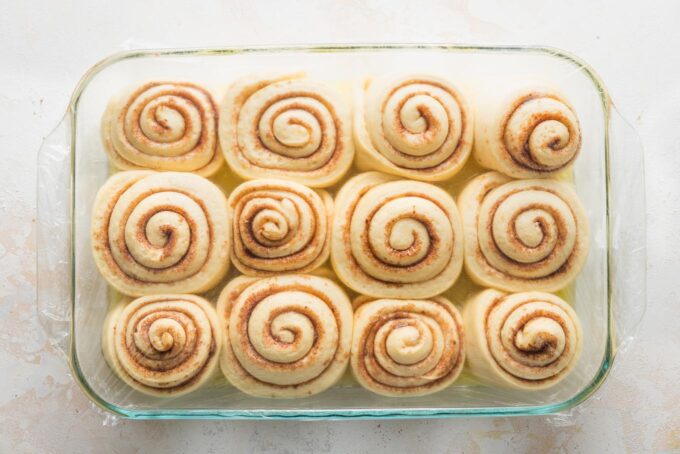
Want to make ahead? Find detailed instructions in the recipe card below.
Bake, flip, and serve.
Bake. When ready to bake, remove the plastic wrap and bake rolls for 25-30 minutes at 350°F. They should be golden brown on top and completely cooked through.
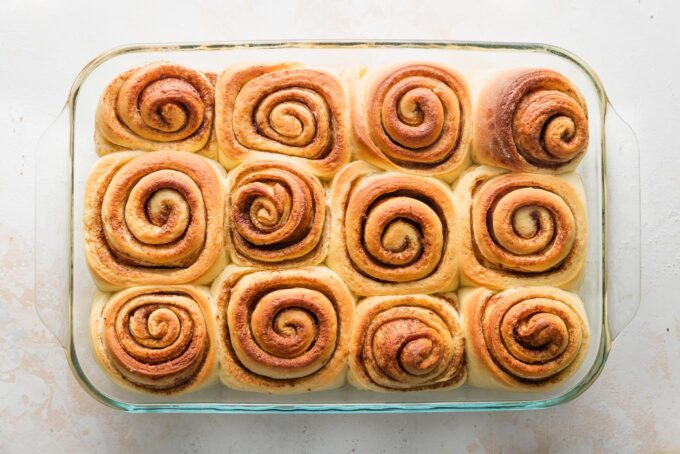
Flip. After removing the rolls from the oven, turn the baking pan over so that the rolls fall out and the glaze runs out on top of them. You can do this onto a serving platter if you have one that is larger than the pan, but I find it easiest to just use a large sheet of parchment paper on the counter.
Flip the pan upside-down, leave it for 2-3 minutes, then gently lift it up and away. The rolls should fall out onto the parchment or plate, with the glossy orange glaze on top.
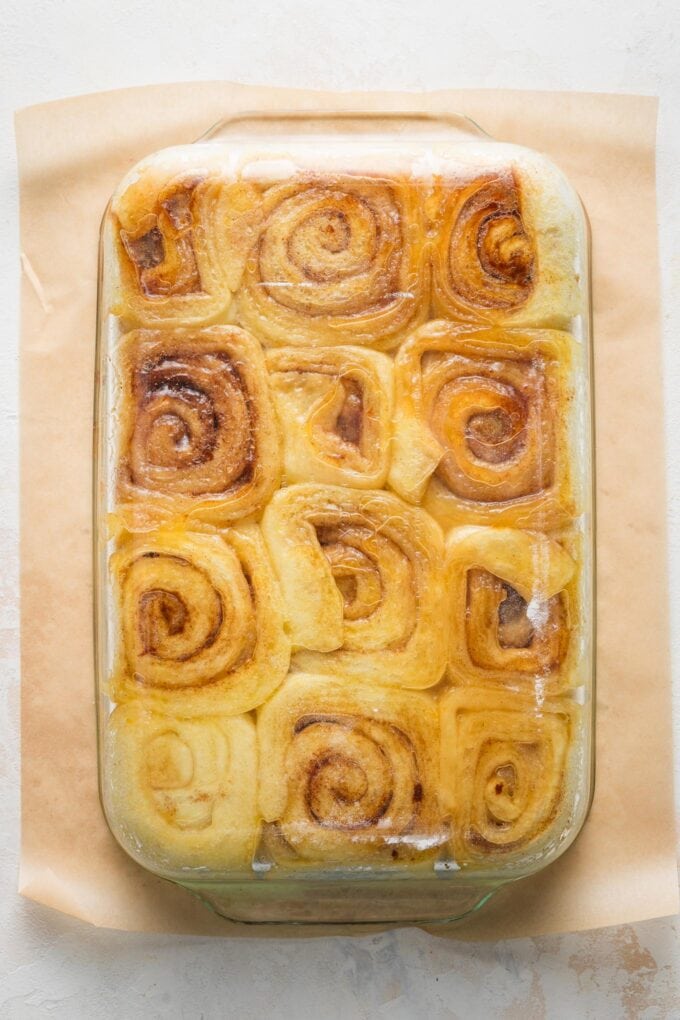
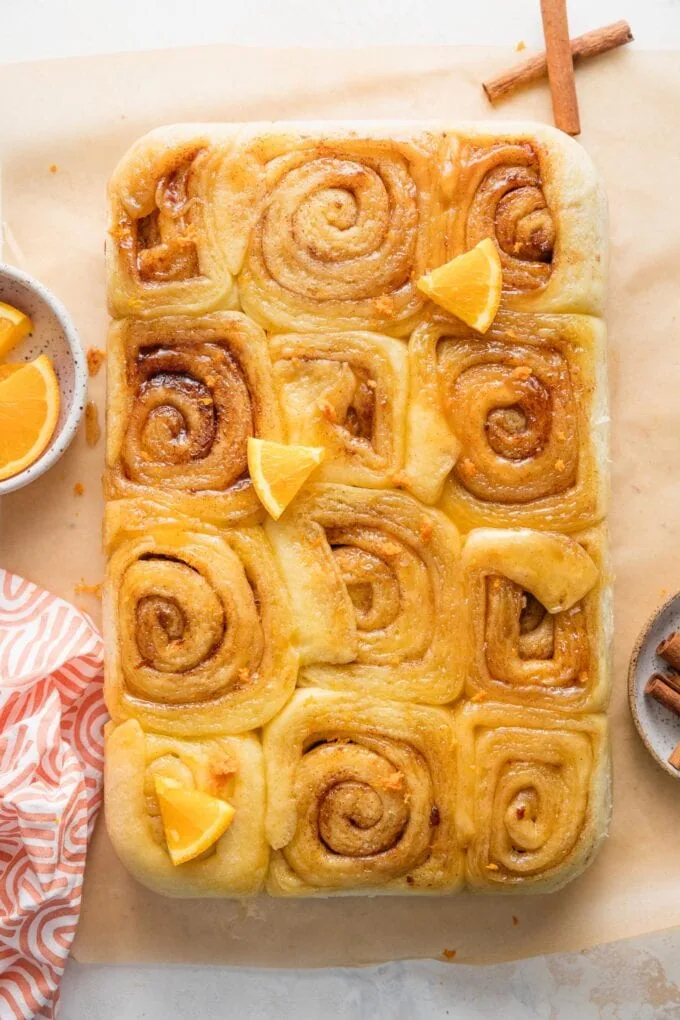
They might look a little smooshed together at first, but I think they look pretty and inviting if you just gently pull the rolls apart.
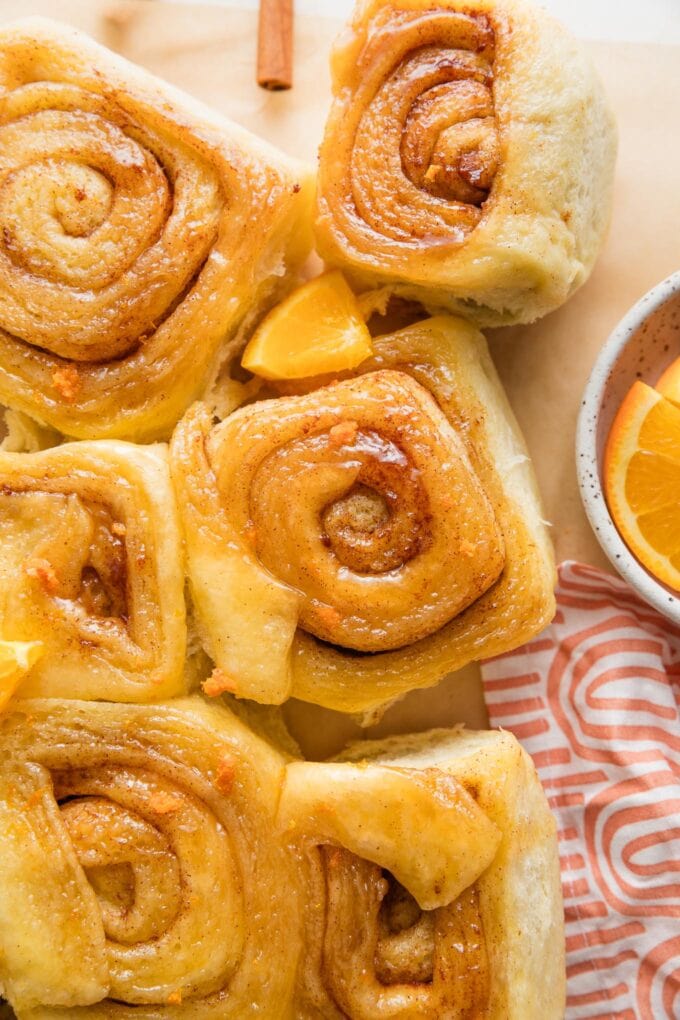
Sprinkle with a little orange zest, if desired, and dig in! Extra orange wedges earn you bonus points for presentation.
Serving Suggestions
These rolls make a fantastic breakfast or brunch for any holiday or special occasion. They pair especially well with a savory item like Mediterranean frittata, sausage cheddar egg bites, or a ham and Swiss quiche.
Add your favorite fruit salad or bowl of berries, a colorful peach arugula salad, and you have a delicious and elegant spread.
Glazed Orange Sweet Rolls
Ingredients
For the dough:
- 1/2 cup warm water between 105-110°F
- 2 and 1/4 teaspoons instant yeast
- 1/4 cup granulated sugar
- 1 Tablespoon orange zest from 1 medium-large Navel orange
- 1/2 cup orange juice
- 1 large egg
- 2 Tablespoons unsalted butter or coconut oil at room temperature
- 1 teaspoon table salt
- 3 and 1/4 cups all-purpose flour
For the filling:
- 1/4 cup unsalted butter very soft
- 1/3 cup light brown sugar
- 1 Tablespoon ground cinnamon
- 1-2 teaspoons orange zest
For the glaze:
- 1/3 cup granulated sugar
- 3 Tablespoons orange juice
- 3 Tablespoons unsalted butter
- 2 Tablespoons light corn syrup
Instructions
- Make the dough. Measure warm water into a small liquid measuring cup. Sprinkle yeast over the top and set aside briefly.1/2 cup warm water, 2 and 1/4 teaspoons instant yeast
- In a large bowl, combine sugar and orange zest. Rub the mixture between your fingers for about 1 minute to infuse the sugar with orange flavor. Add the yeast and water.1/4 cup granulated sugar, 1 Tablespoon orange zest
- Add the orange juice, egg, butter or coconut oil, and salt to the mixture. Add 2 cups of the flour and beat well with either an electric mixer or by hand until the mixture is smooth.1/2 cup orange juice, 1 large egg, 2 Tablespoons unsalted butter or coconut oil, 1 teaspoon table salt, 3 and 1/4 cups all-purpose flour
- Add the remaining 1 and 1/4 cups flour. Switch to the dough hook, if using a stand mixer, and knead the mixture until a dough pulls together, then becomes smooth and elastic. Add up to 1/4 cup more flour if necessary. The dough should cleanly clear the sides of the bowl and come together into a ball that is slightly tacky to the touch, but does not adhere to your fingers.
- First rise. When the dough is ready, lightly coat a large bowl with cooking spray or oil. Place the dough in the bowl, and turn it to coat with the spray or oil. Cover with plastic wrap or a clean kitchen towel and let rise in a warm place until doubled in bulk. This usually takes 1-2 hours, depending on how warm your environment is.
- Prep filling. While the dough rises, prepare your filling ingredients, pan, and the glaze. Set out butter to soften, and combine brown sugar, cinnamon, and zest in a small bowl; set aside.1/4 cup unsalted butter, 1/3 cup light brown sugar, 1 Tablespoon ground cinnamon, 1-2 teaspoons orange zest
- Coat a 9×13-inch baking pan lightly with cooking spray.
- Make the orange glaze. Combine sugar, orange juice, butter, and corn syrup in a small saucepan over medium-high heat. Bring to a boil and let the mixture bubble rapidly for 60-90 seconds, then remove from the heat and pour into the greased pan. Gently spread the glaze evenly across the bottom.1/3 cup granulated sugar, 3 Tablespoons orange juice, 3 Tablespoons unsalted butter, 2 Tablespoons light corn syrup
- Shape the rolls. When the dough has doubled in size, punch it down and turn it out onto a lightly floured work surface. (A pastry mat is great for this.) Roll it out into a large rectangle, approximately 12”x16”. Spread evenly with the softened butter, then sprinkle evenly with the cinnamon sugar.
- Use a pizza wheel or sharp knife to cut the dough rectangle into 12 fairly equal strips, then gently roll each strip up into a cinnamon roll shape. Arrange them over the glaze in the pan, leaving space between the rolls. (You also can roll up the whole log, then slice that into 12 equal pieces; this is the more traditional method, but I find the "cut, then roll" method transformative for keeping the rolls tall, round, and even.)
- Second rise. Cover the pan with plastic wrap. Let the rolls rise in a warm place for 30-45 minutes, until they are puffy and fill the entire pan.
- Make ahead option. You alternatively can store the plastic wrap-covered pan in the refrigerator overnight. When ready to bake, remove rolls from the refrigerator and let stand at room temperature to rise again. After 45-60 minutes, they should appear puffy and fill the pan.
- Bake. When ready to bake, heat the oven to 350°F. Bake rolls for 25-30 minutes, until lightly golden on top. (You can use an instant read thermometer to verify that the rolls are baked through; they should reach about 190°F.) If necessary, cover the pan with aluminum foil toward the end of the baking time to reduce browning.
- Flip and serve. Lay a platter or a piece of parchment paper larger than the baking pan out on the counter. After removing rolls from the oven, quickly turn the pan upside down onto the platter or parchment. Leave the pan upside-down for 2-3 minutes, then gently lift it up and away. The rolls should fall out onto the plate, with the orange glaze on top.
- Serve warm, garnished with an extra sprinkle of orange zest, if desired.
Nutrition Estimate
This post was originally published on April 15, 2022. It has been updated with new photos, tweaked instructions for the best pan to use, and more helpful tips and tricks in the post text.
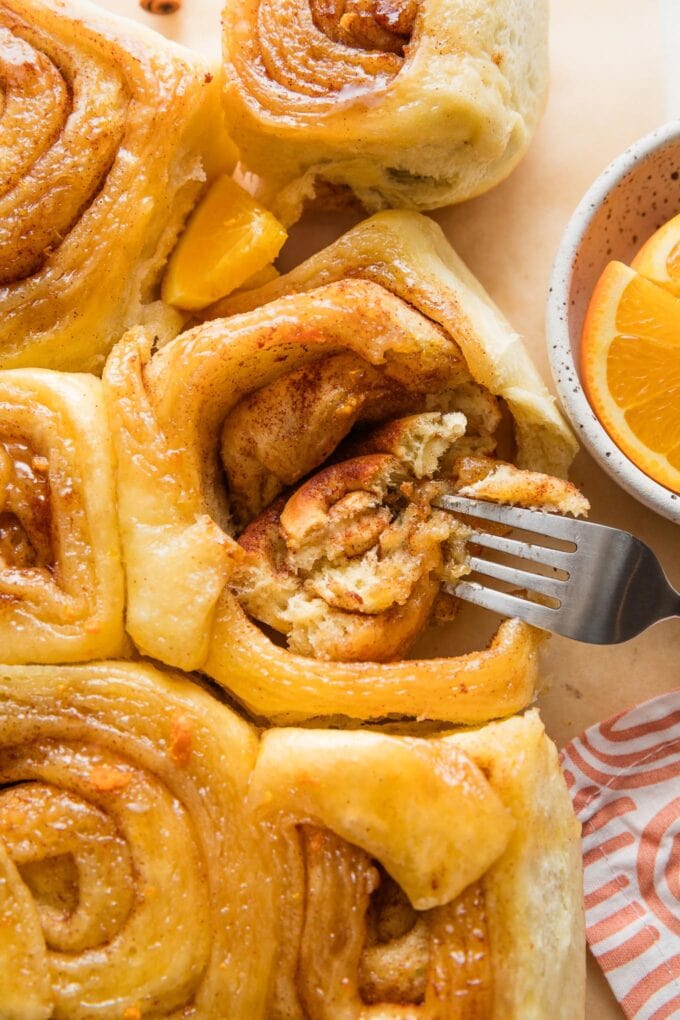
More Q&As and Tips for Success
Can I make homemade rolls without a stand mixer?
Yes! You can make these without a stand mixer, just be prepared to put in a little elbow grease when making the dough, and knead it very well by hand before setting aside for the first rise.
Can I make these ahead?
Yes! The day or night before you want to bake and enjoy these orange rolls, make the dough, complete the first rise, fill it, make the glaze, and arrange the rolls over the glaze. Cover with plastic wrap and store in the refrigerator overnight. Remove and complete the second rise at room temperature the following morning, then bake as directed.
How to tell when cinnamon rolls are done baking?
If you have an instant-read thermometer, you may be most accustomed to using it for meat, but it’s a great asset when baking bread and rolls, also! Test the middle of a roll — it should be between 180-190 degrees F for the rolls to be perfectly baked.
Other Favorite Sweet Breads and Muffins
If you love making sweet breads and breakfast treats, don’t miss these other favorites:
- The Ultimate Five Banana Banana Bread
- Lemon Olive Oil Zucchini Muffins
- Lemon Poppy Seed Muffins
- One-Bowl Blueberry Almond Muffins
You can also FOLLOW me on PINTEREST, INSTAGRAM, and FACEBOOK for more great recipes and ideas!
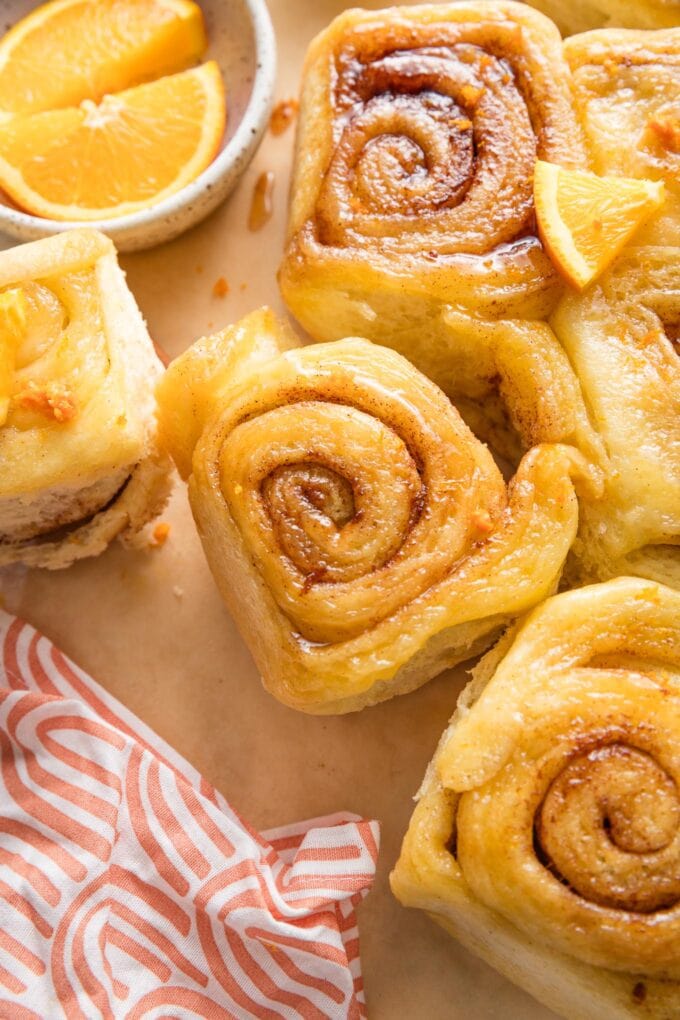

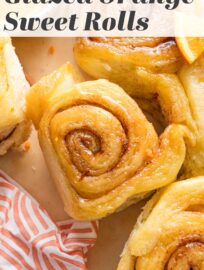
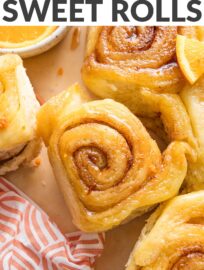





We truly cherish this recipe and have worked hard to perfect it over time. I hope you love it as much as we do!